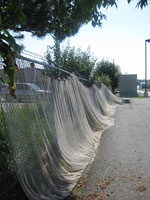

 | |||||||||||||
|
|
Journals 2009/2010Teresa Gable
August 19, 2009 Today was a lab day. The lab was busy with everyone getting caught up on their research. I spent the morning working on categorizing my photos and working on my journal. I met with Suzi Ryan and the website designer for the Gulf of Maine Research Institute and we decided to put some of my photos on their website also. The afternoon was spent watching and learning from the different research projects. I watched how Abby and Elizabeth painstakingly identify the species of each unknown plant. I was able to use the dissection scope to view some of the interesting parts of the plants.
Colleen and I mended a huge net with several holes in it for use in the field on Thursday. One hole was created by a large Northern Pike fish that tried to escape and damaged the net. It was a very long trammel net used to capture large fish in the pond. The net is long and has a few layers so fish get tangled in it very easily. We stretched it out over a long fence and looked for holes and sewed the holes with fishing line. This took awhile.
I had the opportunity to watch and ask questions concerning preparing the water sample for chlorophyll-a analysis. This is a three step process. Step one is to filter the water sample and freeze the filter for 24 hours. Step two is extraction. The filter is extracted through a glass fiber filter and dissolved in a solvent and put in a centrifuge and stored for 24 hours. The last step is to take the sample and read the light absorbency value using a spectrophotometer. A mathematical formula will be used to determine the amount of chlorophyll-a present in the water. This process is conducted with the lights off to keep the chlorophyll-a from breaking down before measurement. I also got to watch the dissection of some alewife. Each fish is weighed and measured. A few scales are removed to determine the age of the fish. I was able to look at the slide under the microscope to determine that the one alewife was 6 years old. The scales have growth rings like trees, one year per ring. This was interesting to see.
The gonads are removed and weighed so the sex can be determined. The gonads are studied to determine the reproductive status of each fish caught in various water bodies. The larger the gonads, the more eggs they can carry, the healthier the fish is reproductively. Environmental factors are studied to determine why some fish are more successful at reproducing then others. A muscle tissue sample or fin clip is collected to send out for micro DNA analysis. |
||||||||||||


